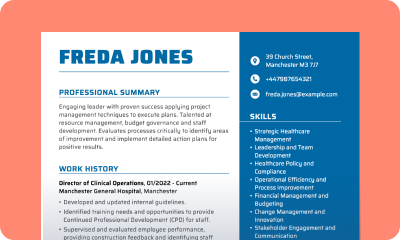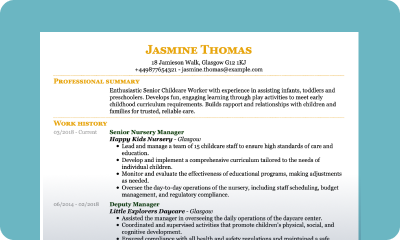- Our customers have been hired by : *Foot Note
As a train driver, it can be difficult to sum up your experience on a CV. Whether you’re operating a train, minimising timetable delays, or carrying out routine maintenance, it’s crucial to convey the full range of your skills when writing an application. But with only one or two sides of A4 to do it in, it can be challenging to stay on track.
The good news is that myPerfectCV can help. Explore our selection of train driver CV examples, then use our proven CV builder tool to create your own. It’s quick and easy to create your train driver application today.
To get you started, we’ll run through everything you need to know below. That extends from our sample and template options to structural advice, dos and don’ts, and even guidance for each section of your CV:
SEARCH ALL CV EXAMPLES
Sample train driver CV
David Dunne
8 Holgate Rd
Bristol BS2 9NF
987654321
david.dunne@example.com
Professional summary
Responsible train driver with strengths in operating diesel or electric trains. Punctual and thrives focused on driving safely. Regularly inspects train before departure to manage wear and tear.
Work history
March 2023 – Current
Bristol Rail Services – Bristol
Train Driver
- Upheld passenger safety by observing signals, nearby traffic and track conditions.
- Followed strict timetables to operate trains from stations and depots to specified destinations.
- Absorbed and retained knowledge of rules, regulations and operating notices for maintaining smooth train operations.
- Monitored and moderated train speed to guarantee safe travel.
January 2019 – February 2023
Bristol Rail Services – Bristol
Assistant Train Driver
- Provided clear updates of delays and route changes to passengers and on-board staff.
- Responded to service faults and failures by reporting to the control room.
- Maintained focus and situational awareness of conditions on train networks to guarantee smooth train operations.
- Attended daily pass-down meetings for a full update on systems and trains before shift.
Skills
Control panel operation
Emergency procedures
Route knowledge
Timetable management
Signalling expertise
Depot communications
Pre-start locomotive inspections
Safe locomotive operation
Critical incident reporting
Train management techniques
Train shunting
Strict schedule coordination
Education
2016
Bristol Railway Training Centre Bristol
Train Driver Certification Programme
2015
Bristol High School Bristol
High School Diploma
Train driver CV format
The first step is to select from a range of established CV formats. Consider your format as the framework of your CV, the foundation that allows you to add in all your credentials and important information. For a train driver, you should choose a CV format that best showcases your qualifications for the role. Among the various formats available, two stand out for this job.
The first recommended format is the reverse-chronological CV. This format starts with your current or most recent job and moves backward through your employment history. This layout enables the reader to quickly understand the extent of your experience and assess your suitability for the train driver position.
If you’re shifting careers into train driving from a related field and don’t have direct experience, a skills-based CV is a beneficial alternative. This format emphasises transferable skills that can fit the job.
A reverse-chronological CV is your best if you have relevant experience. If not, a skills-based CV can be equally effective. Remember that for a train driver, you will need specific training. When preparing your CV for a train driver position, keep in mind the following key tips:
- Use headings, bullet points, or section breaks to break up long text sections for better readability.
- Strive for a short, concise CV, ideally limited to one or two pages.
- Choose clear fonts like Calibri, Times New Roman, or Arial.
- Customise your CV to match the job advertisement’s requirements.
- Submit your CV as a Word or PDF file unless directed otherwise.
How to write a CV for a train driver
In the sections that follow, we are going to explain how to write a CV for a train driver. We will break down each section of content you will need to include, so that you can tick all the boxes you’ll need for an employer.
Here is some of what we are going to take a look at:
- Adding contact details to your train driver CV
- Train driver CV personal statement
- How to present your work history on a train driver CV
- Great skills to add on your train driver CV
- How to add education to your train driver CV
Adding contact details to your train driver CV
An often underestimated but vital section is your contact details. How can a potential employer call you up for an interview, if they can’t find how to contact you? You will find that many candidates fall at the first hurdle and forget this section all together. By adding a concise and easy-to-spot contact section, you can make sure you never miss an opportunity.
You should aim to make this section slightly larger than the others, or in a bold font, somewhere near the top of your document. When writing your contact details, you should always include:
- Your full name – no need to write your middle name.
- Address or location – so the employer knows where you are based.
- Your phone number – use a mobile if you have one.
- Email address – ensure you use a work-appropriate email address.
Example of contact section for a train driver CV
Kiara Connell
444 Kingsway,
Manchester M60 3TT
07912345678
Connell.k@example-example.co.uk
Train driver CV personal statement
Sometimes called your professional summary, the personal statement section of your CV is an important first impression. You should add in the most impressive aspects of you as a candidate – and use them to hook the reader and get them to read more about you. However, you’ll only have 3-4 short sentences to do so.
Begin your personal statement with a short introductory sentence that engages the reader. Try to keep it snappy, only explaining your career focus and experience level. The idea is to hook the reader and make a short, compelling case that you are the right candidate for the position.
Your second sentence should include a real-world fact or figure that helps back up your statements about yourself. Let’s say you have already driven hundreds of miles as a train driver in a previous position – this would be the moment to mention it! Using a tangible figure will lend a sense of authority to your CV.
Your third and fourth sentences should be reserved for highlighting your special skills. In these sentences, you should explain to the reader what makes you unique. Use the third person to sell your skills and capabilities rather than focusing solely on you.
As a train driver, hundreds of people will put their trust in you every day. To show recruiters you’re up to the task, include positive words to describe your work ethic in the personal summary section of your CV. These could consist of “resilient”, “reliable”, “diligent”, or “meticulous”.
Example of personal statement for a train driver CV
Reliable train driver with 7+ years of experience safely transporting passengers according to strict timetable requirements. Utilises advanced engineering knowledge and sound customer service skills to provide first-class travel experiences.
OR
Dedicated and safety-conscious professional with extensive experience in the transportation industry. Possesses a strong foundation in operational safety, route planning, and customer service, with a 95% rate of customer satisfaction. Committed to ensuring passenger safety and comfort, as well as responding calmly and effectively in high-pressure situations.
How to present your work history on a train driver CV
The work history section of your CV is likely to be the longest, especially if you’ve chosen a reverse-chronological CV format. Managers value hands-on experience above all else, which is why you should spend a lot of time getting this section right. The process of writing this section is simple, however.
Begin with your current or most recent relevant job role, and work backwards through time. Aim to add up to 5 or 6 responsibilities for each role, making sure that each one is unique and adds to the picture of you as a candidate.
What are some other important tips for your work experience section? You need to make sure that each responsibility you add expands your experience level. You want to show that you have a comprehensive history of important experiences that make you prepared for the role. With that in mind, don’t repeat responsibilities or add irrelevant tasks that won’t impress the employer.
Another thing to remember is to use strong language choices. Positive adjectives, for example describing yourself as “experienced”, or “safety-conscious” give a good impression of you. Also be sure to use action verbs instead of “responsible for”. You might say that you “led”, or “conducted”.
Example of work experience for train driver CV
January 2023 – Current
Train Driver | National Rail | Manchester
- Maintained meticulous focus and situational awareness of conditions on train networks to ensure smooth train operations and minimise errors.
- Reported defects to engineers and management immediately to minimise delays.
- Observed signals, track conditions, nearby traffic and prescribed speeds to maintain passenger safety.
- Monitored train speed and signals to ensure safe travel.
- Made clear, concise announcements to passengers and on-board staff. Providing detailed updates of delays and route changes.
January 2021 – December 2023
Trainee Train Driver | National Rail | Manchester
- Exchanged information and updates with other drivers, station guards and security to maintain cohesive services.
- Assisted passengers with luggage as needed, providing warm, friendly service to ensure satisfaction.
- Performed thorough train inspections prior to departure to safeguard passenger and staff wellbeing.
- Safely operated trains from stations and depots to specified destinations according to strict timetables.
- Performed ongoing adjustments and repairs prior to operation, escalating as needed.
Great skills to add on your train driver CV
The next important section of your CV involves listing a series of essential and desirable skills. You should aim to split these between hard and soft skills. What is the difference between these? Hard skills are anything you’ve learned on the job, like specific train driving experience. Soft skills are more like positive character traits that help you to stand out. You should aim to get a balance to show that you are a balanced candidate.
The role of a train driver calls for a wide range of CV skills. Stop at every station by including all the train driver skills and qualities your recruiter wants to see.
Essential skills for your train driver CV
- Train driver licence
- Safety knowledge
- Attention to detail
- Adaptable
- Customer service
- Mechanical skills
Bonus skills that could help you stand out
- Problem-solving
- Teamwork
- Traction knowledge
- Area route knowledge
- Fit and healthy
How to add education to your train driver CV
The final section of your train driver CV should be dedicated to your educational history. You can think of this as your chance to show you have the brains to back up your experience and listed skills. Here, you can outline any relevant qualifications you’ve picked up over the years, as well as any essential train driving training you have undertaken.
Aim to add the most relevant qualifications when it comes to any university, college, or secondary school courses you have taken. Any professional training qualifications can also help to supplement and strengthen your application.
Try to be precise with the qualifications you choose. Make sure to leave out any bad grades or incomplete courses, as these won’t add to your application.
When writing the education section of your application, always include the following information:
- The name of the educational institution
- Start and end dates for the course
- Official title of your field of study
- Qualification level
- Qualification outcome
Example of education for a train driver CV
Train Driving Diploma
City of Bristol College
September 2021 June 2023
Level 3 EAL
Passed with Merit
National Diploma in Engineering
City of Bristol College
September 2019 – June 2021
Level 2 NVQ
Passed with Distinction*
Top FAQs about your train driver CV
What qualifications do you need to be a train driver?
As a train driver, you don’t need any relevant academic qualifications but will need to pass a range of tests. As well as your UK and European train driver qualification, you may also need to hold a Personal Track Safety Certificate or equivalent safety accreditation.
What skills do you need to be a train driver?
A good train driver will have a diverse range of physical and personal skills. As well as being a highly experienced driver, they also need to have excellent time management, attention to detail, and adaptability. These skills will enable them to react to stressful situations and make decisions quickly if required as part of the roles and responsibilities of a train driver. They must also have the ability to work efficiently for long periods and work as part of a wider team.
How do I apply to be a train driver?
If you’re keen to become a train driver, you must meet the necessary application requirements (you should be at least 21 to drive national trains and 18 to drive on the London underground, with a valid UK driver’s licence and proven good health). You will apply directly to your chosen rail network and, if you don’t have experience, will need to complete the training program. This includes gaining a Personal Track Safety certificate, completing hundreds of driving hours, and sitting exams on the mechanical, route, and regulatory information.
How much does a train driver earn?
In the UK, a trainee train driver will usually make between £20,000 and £30,000 a year. Once they are fully qualified, a train driver could earn anything up to £60,000, particularly if they work for a major national rail company.
How many hours can a train driver work?
In general, a train driver will work a 35-hour week – although they need a high level of flexibility as shifts don’t usually fall within the standard 9-5 working hours. Some train driver shifts can last as long as 10 hours and require you to work during the weekends or overnight.
Related 3 Logistics CV Examples & Template for 2026
Reach your career destination with a professional train driver CV
Don’t go off the rails with a sub-par CV. When you use myPerfectCV, you’ll gain access to our range of professional train driver CV templates and CV examples. Our proven CV builder makes it quick and easy to start your train driver application today!
*The names and logos of the companies referred to above are all trademarks of their respective holders. Unless specifically stated otherwise, such references are not intended to imply any affiliation or association with myperfectCV.




